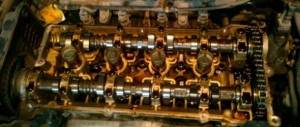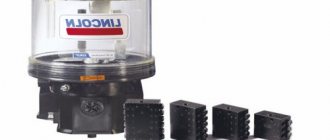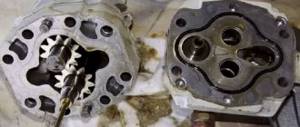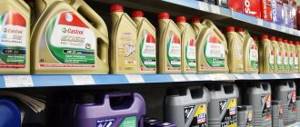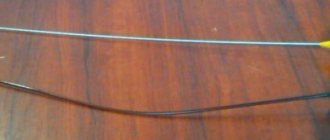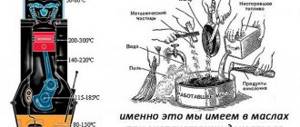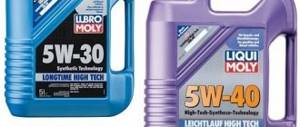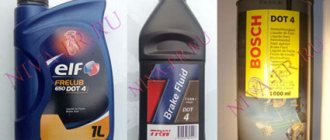How to determine the oil level
Some car owners and craftsmen believe that this should be done “cold”, others – “hot”. The former argue their position by the fact that the lubricant will have time to drain into the sump while the engine is cooling, which will make the measurement more objective. The latter claim that when cooled, it contracts, so the level (especially in winter) turns out to be underestimated. That is why it is better to determine the level in two ways. In the summer, one method is sufficient, since the differences between “cold” and “hot” are insignificant.
Measurement algorithm:
- The machine is located on a level area.
- The engine needs to be turned off.
- After a maximum of a quarter of an hour, the lubricant will drain into the crankcase.
- The driver removes the dipstick and wipes it with a clean rag.
- The dipstick is installed back.
- After 3-5 minutes, the probe is removed again (you must try not to touch the walls of the hole with it, otherwise the measurement result will be incorrect).
Note! The correct level is considered to be between two – maximum and minimum marks.
How to check the oil level
The level of engine oil in the engine is determined using a dipstick, which is located directly in the engine compartment. To get adequate indicators, you need to use a certain algorithm:
- place the car on a level surface;
- cool the engine, at least fifteen minutes should pass after stopping;
- pull out the dipstick and wipe off any remaining grease with a clean rag;
- lower the dipstick into place and remove it again, paying attention to where the oil level is.
On standard car dipsticks there are notches that indicate the minimum and maximum lubricant levels. If the level is below the minimum, it’s time to fill in the lubricant; if it exceeds the maximum, then it would be a good idea to drain some of the lubricant.
In modern cars, the lubrication level is checked by an on-board computer, but at the moment you cannot completely trust the electronics. It is advisable to check the level using the usual method, especially if there is a long trip ahead or the car has just returned from a difficult trip.
How many liters of oil are poured into the engine?
The correct level of this fluid depends on:
- engine type;
- car brand.
Domestic cars are designed for an average of 4 liters. Foreign models will require at least 4.2 liters of lubricant. First fill in about 3.5 liters. Then check its level using a dipstick. The procedure is repeated until the sensor shows the desired rate.
Complete replacement
The car is placed level and horizontal, the engine is warmed up. Having previously prepared a certain container, open the oil filler cap. All that remains is to remove the filter and unscrew the plug in the crankcase pan.
The used lubricant is drained. Rinse off the residue with fresh liquid (0.5 l is enough). Then the drain plug in the pan is tightened with force.
Note!
If there is a sealing ring under the drain plug, it must be replaced with a new one. Also, when completely changing the oil, a new profile filter is installed.
After filling, close the lid and allow the engine to idle. Be sure to inspect the surrounding area for possible leaks. Pay attention to the oil pressure light. It should go out. After a few kilometers the level should be checked again.
Note! The so-called “express change” of engine oil is acceptable - in this case, the lubricant is not poured out, but is pumped out through the hole for the dipstick. This is rather a forced measure. After all, used lubricant remains in the engine, which is mixed with fresh lubricant, thereby reducing its service life (the service interval is reduced by 3-5 thousand kilometers traveled).
Adding oil
It should only be added to the engine when it is warm. When measuring on a cold engine, the level may be less than actual. Is it permissible to mix lubricants from different manufacturers? – Yes, but you must adhere to the rules:
- synthetic options are mixed only with synthetic ones;
- mineral – with mineral;
- semi-synthetic - with any.
Engine oil consumption
Car enthusiasts are faced with the question: “How many liters of oil are in the engine?” It is easy to determine this figure from the car's passport. Practice shows that in reality, slightly less oil is poured into the engine than shown in the passport data.
Because in fact, when draining waste, the entire volume of existing motor fluid in the engine is not removed. Some of it remains in the internal cavities, a fairly significant proportion is distributed along the internal walls.
In modern passenger cars with a power unit displacement of 1.4...1.8 liters, the amount of oil in the engine is 3.5...5.5 liters.
During the operation of the vehicle, part of the lubricant burns out during fuel combustion, another certain proportion evaporates through the breather connecting the crankcase to the environment, and a certain amount flows out through leaks in the connections of various units. Engine oil consumption is not constant.
It depends on many factors:
- technical condition of the vehicle. A new car, as well as one that has undergone current or major repairs, has minimal engine oil consumption. For a used car that has quite a significant mileage between repairs, this figure is much higher;
- terms of Use. It is no secret that in urban conditions, when the idle time in front of a traffic light takes as much as actual movement, and is also accompanied by a dynamic start and similar braking, it is characterized as a high-load mode. Driving outside the city at a constant speed and without sudden lane changes is more favorable for the vehicle, although the actual mileage may be many times higher than the city traffic regime;
- the type of motor oil used in a particular engine. Today on the market there are: mineral, semi-synthetic and synthetic types. Each of these types has its own undeniable advantages, as well as disadvantages;
- region of residence and operation of the vehicle. Residents with a sharply continental climate, characterized by hot summers and extremely cold winters, notice that their cars have high engine oil consumption. Residents of areas with warm (not hot) summers and moderately cool winters add oil much less often during operation of their car.
How do you know when the oil needs to be changed?
Constant oil monitoring allows you to visually determine when an oil change is required. There is still no clear answer when to do this.
When to change the fluid? If there is excessive fluidity of the material or a jelly-like substance, as well as blackening, the appearance of suspended substances, a strange foreign odor, then this moment has arrived. You should also be concerned if the lubricant forms foam or emulsion.
Top or bottom mark?
If the lubricant level is below the minimum dipstick mark, then the car will not be able to operate normally. Due to oil starvation, the crankshaft may jam.
When the amount of oil becomes too high, the pressure in the engine increases. Worn seals can burst.
So how many liters of oil should be poured into the engine to prevent such problems from occurring?
It is recommended to bring the oil level to almost the maximum level. In this case, all parts will be well lubricated.
Many drivers try to maintain the lubrication level at an average level, although every engine “eats” oil fluid. It is advisable to add extra oil.
Be careful when adding oil for the first time. There is no need to try to reach the maximum mark.
If you fill the engine with lubricant and wait for some time (about an hour), the level will increase on its own. This is due to the fact that it takes time for the oil to move into the sump through all the parts of the internal combustion engine.
The optimal level will reach a level above normal
How to add car oil if you have waited an hour, but there is still not enough lubricant?
Pour the consumable in small doses of 100-200 ml. It is recommended to top up in the morning, after the machine has been idle for a long time. In this case, the oil will fill the pan to the maximum.
Engine oil level - low and high
If the oil level drops below the minimum permissible level, the vehicle cannot be operated. This will lead to:
- poor cooling of contacting parts;
- motor overheating;
- wear of main components.
Engine lubricant level is higher o? Overflow is the reason:
- increasing pressure in profile systems;
- violation of the lubricant viscosity required for the engine;
- squeezing out oil seals;
- deterioration of the tightness of components and individual parts.
Due to increased frictional resistance, oil consumption will increase and it will foam. This will lead to carbon deposits and contamination of the spark plugs. And to unplanned car repairs. Don't rely on your own strength? In this case, you need to contact a car service, where you will be competently advised on all the necessary questions.
How much oil should be poured into the engine
To accurately answer this question, you need to know the make and model of the car, since the volume may differ for each car. Information can be obtained from the vehicle's owner's manual, which contains data on the required quantity. However, even with this information, in practice, car owners often face difficulties.
How much oil should be poured into the engine? After all, the norm must be strictly defined.
If you take a domestically produced car, then for an engine volume of 1.8 to 2.5 liters you will need three and a half liters of oil. Therefore, three liters are poured first, and then, a few minutes later, after checking the measurement, the rest is added. If the level is low, add it little by little in small portions until the required level is reached.
For cars of foreign production, oil with the same engine volume usually requires more - from 4.2 to 4.4 liters. Top it up in the same way as when refueling domestic cars.
Consumable replacement frequency
Every car owner needs to know how often the engine oil needs to be changed. Typically, the recommended frequency is indicated by the car manufacturer in the owner's manual.
The average replacement frequency is ten thousand kilometers.
You need to start counting kilometers after you have drained the used oil fluid. Be sure to record the start of the countdown. In the future, when operating the vehicle, mark the kilometers you have driven on the speedometer.
In extreme cold, as well as under harsh operating conditions, you need to change the oil more often for at least a couple of thousand kilometers. This is due to the additional work that the car performs while idle in traffic jams, as well as during the morning warm-up.
Consequently, the replacement frequency for cars that are used in large cities or in winter is once every eight thousand kilometers.
Changing the oil fluid at a car service costs approximately five hundred rubles. In this case, the owner of the car buys the lubricant and oil filter.
Sometimes car services organize promotions, replacing consumables for free if the driver bought a certain oil.
In any case, it is much more profitable to change the car oil yourself. This provides an opportunity to greatly save your own money and time.
How to determine the amount of oil in the power unit?
Not everyone knows how to determine how much oil is in the engine. The amount of lubricant can be determined by the container from which the oil was poured. It is necessary to measure it and add approximately ten centimeters of the residue that does not drain.
The displacements of automobile manufacturers differ significantly from each other.
If you do not know how much fluid to use when changing the oil, contact a special forum or an experienced car owner who drives the same brand of car as you.
It is undesirable to carry out the procedure without knowing the exact volume of lubricant required, because any internal combustion engine has its own design features.
In Russia, almost every motorist knows the displacement for VAZ cars. A VAZ 2107 needs 3.75 liters of lubricant. For VAZ 2108/2109 you will need three liters of oil fluid.
